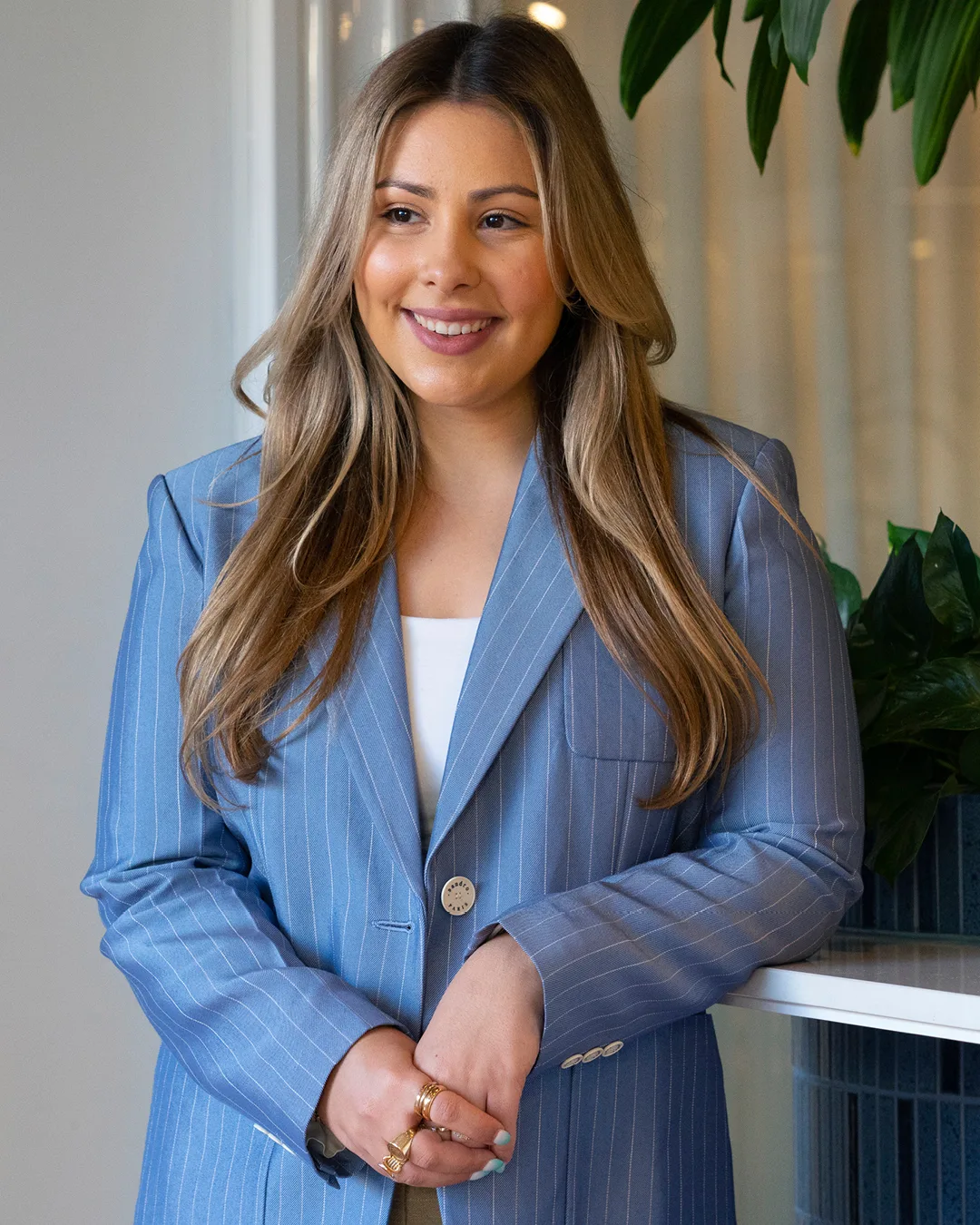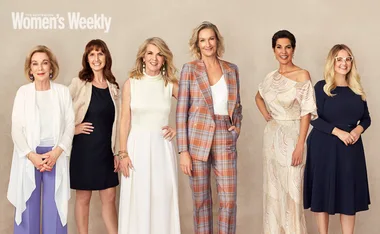Cleaning up the beauty industry, delivering sustainable energy to the Pilbara and a support network for rural mothers.
The inspiring 2022 Women of the Future finalists are boldly changing the world.
Natassia Nicolao – Conserving Beauty
When The Weekly called Natassia to ask about her waterless beauty brand, Conserving Beauty, the founder and CEO was training staff at New Zealand MECCA stores that would soon stock her innovative products, which use no water and leave no waste.
A science graduate with a major in biochemistry, Natassia spent the early years of her career in the beauty industry, focusing on ethical sourcing and product development. She wondered why the industry was having conversations about recyclable packaging but not water conservation.
Having grown up in an era of water restrictions, it struck her as a major oversight.
“Water is involved in every stage of a product life cycle,” Natassia says. “I kept thinking, the world doesn’t need another beauty brand but it does need someone to do sustainability well and redefine what that means.”
In late 2021, Natassia launched Conserving Beauty to help reduce the beauty industry’s water footprint and reduce waste. No water is used in the products’ manufacture.
“We have a fabric [for facial wipes and sheet masks] that completely dissolves in water after use. We’re really trying to help reduce the beauty industry’s water footprint and inspire conservation within the beauty industry.”

Natassia has created a waterless beauty brand to help reduce the beauty industry’s water footprint.
(Photo: Supplied and used with permission)Nikita Fernandes – Ally Assist
Nikita grew up helping to care for her younger sister, Anushka, who has physical and intellectual disabilities, so she understands how difficult it is to navigate the disability system.
In 2018 she co-founded Ally Assist, which has already enabled 500 people living with a disability to access 30,000 hours of therapy using Allied Health Assistants.
“People with disability can now practise therapy strategies at home for a third of the price of working with an allied health professional. Instead of paying $240 an hour, they now pay $80,” Nikita explains.
“Our solution helps three groups of people. People with disabilities can triple the amount of therapy they get with the same NDIS budget and it gives their unpaid, untrained carers much needed respite. Secondly, university students gain meaningful, paid work experience. This hands-on, relevant work equips them for their careers after graduation.”
It’s good for therapists, too.
“Many allied health professionals were getting overwhelmed and leaving the sector,” Nikita says.
Now they have all the help they need to handle their client load. Ally Assist has grown rapidly in the past four years, with clients in Victoria, NSW, WA, SA and Queensland.

Nikita created Ally Assist after helping to care for her younger sister, Anushka.
(Photo: Supplied and used with permission)Sophie Li – SignHow
Sophie was born in Texas, where her father, Li Cunxin, and mother, Mary McKendry, were principal dancers with the Houston Ballet company.
They couldn’t wait to share their love of ballet with Sophie. But one day she was holding a balloon that suddenly burst. Everyone jumped, except her.
Sophie was profoundly deaf. At four years old she was fitted with a Cochlear implant and first heard sound.
Sophie did speech therapy but she didn’t begin learning Auslan – Australia’s own sign language – until she was 23, and was surprised by how difficult it was to find resources to support her.
“I tried to learn on an old e-dictionary but most of the signs were outdated. I then tried to learn via YouTube, printed dictionaries, Facebook. I almost gave up, but a fire inside me had ignited.”
So, with co-founder Nikhil Bora, Sophie designed and built SignHow, a global, online, accessible dictionary comprised of community-generated videos of signs from different sign languages around the world.
“This will improve educational outcomes, which in turn will open more employment opportunities and give the marginalised community a choice and a say in their quality of life.”

Sophie has created SignHow – a global, online, accessible dictionary for sign language.
(Photo: Supplied and used with permission)Gemma Lloyd – WORK180
Gemma spent seven years working in the tech sector, mostly for companies she now sees as archaic boys’ clubs.
She had just started a new position in a well-paid role when two things happened: She discovered that her male colleague’s salary was $40,000 more than hers, and her manager told her to ignore a sexist comment in order to preserve a relationship with a client.
“It just made me physically sick that I was going to have to deal with a client and my manager was completely okay with comments like that. I went home and WORK180 was born,” she says.
WORK180 is an employment platform that was created to endorse and promote workplaces with a true commitment to gender equity and diversity. It provides a search engine that features only approved employers who have policies that support women in the workplace.
“Women are able to look at these policies transparently and see what companies do have and what they don’t have,” Gemma says.
Once employers join, WORK180 works with them to ensure they are continuously improving.
At a minimum, companies on the WORK180 platform need to offer six weeks maternity leave at full pay. Gemma says half the companies WORK180 has vetted have failed that basic test.

WORK180 is an employment platform that was created to endorse and promote workplaces with a true commitment to gender equity and diversity.
(Photo: Supplied and used with permission)Stephanie Trethewey – Motherland
Stephanie was a reporter, covering an agricultural event, when she interviewed the man who she’d go on to marry.
“I didn’t realise what falling in love with a farmer would actually mean for my life,” she says, laughing as she recalls thinking episodes of The Farmer Wants a Wife and River Cottage would prepare her.
When Stephanie found herself living in regional Tasmania with six-month-old baby Elliot, “it was a real baptism of fire,” she says.
“I wasn’t prepared for the unique challenges that come with raising kids on the land, and the isolation was crippling. With no family, friends or mothers’ groups nearby, it became very clear that too many rural women are raising their children without a village, and they desperately need one.”
Her husband was working seven days a week and Stephanie was battling postnatal depression so she created Motherland, a podcast telling stories of motherhood on the land.
To date it’s had over 370,000 downloads. But Stephanie still felt alone, so after her daughter Evie, arrived at the end of 2020, she created Motherland Village, an online rural mothers’ group that connects rural women to their own personalised support group.
Each ‘village’ is guided through a facilitated six-week online program.
“It means rural mums, whether they’re living on a cattle station in the middle of the NT, or 20 minutes away from me in Tassie, can have access to a mother’s group.”

After moving to the country and having two babies, Stephanie noticed there was no support for new rural mothers.
(Photo: Supplied and used with permission)Brigette McDowell – Cheeditha Energy
Brigette McDowell is the CEO of the largest renewable energy company in the Pilbara, Cheeditha Energy, which she co-founded with elders from the Yindjibarndi community.
Cheeditha harnesses the region’s “endless supply of sunshine” with the goal of achieving a net-zero future, and funnels profits to projects that help bring the Yindjibarndi people out of hardship and provide long-term financial independence.
One way it is doing this is by developing a solar farm on Yindjibarndi land.
“When you realise the people in this region can trace their heritage back 3000 generations, then you realise how important this land is to preserve. And we have a real opportunity to do that,” she says.
Cheeditha Energy works with companies to decarbonise their footprints, providing solutions that include domestic and commercial solar panels, natural refrigerants and other products.
Another of Brigette’s key goals is making it easier for women to participate in the resources industry.
“When I enter a boardroom as CEO, I am continually met by a sea of men asking, ‘When will your manager arrive?’ It’s challenging for young women to embody what they have never experienced. That challenge is amplified for young First Nations women.”

Brigette is CEO of Cheeditha Energy, the largest renewable energy company in the Pilbara.
(Photo: Supplied and used with permission)You can read this story and many others in the October issue of The Australian Women’s Weekly – on sale now


